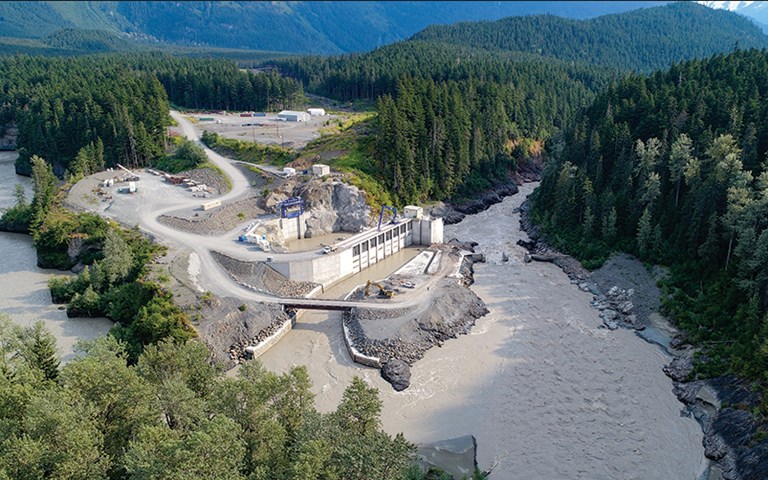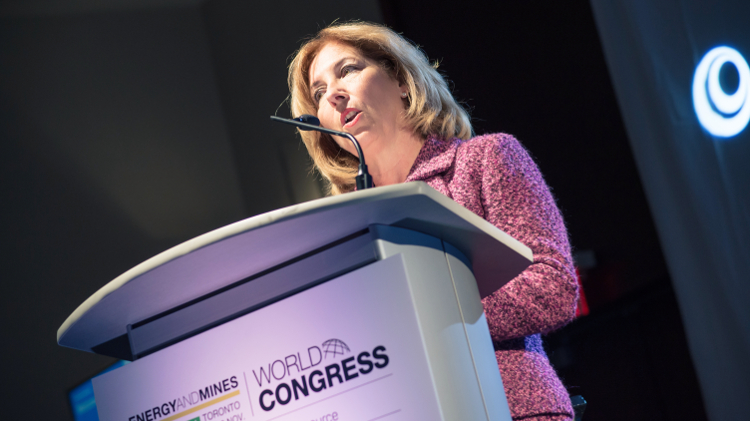Skeena Resource's Eskay Creek project will be powered by hydroelectricity generated by the Coast Mountain Hydro Project, which has three power-generating stations: McLymont Creek, Volcano Creek and Forrest Kerr (pictured above) located in British Columbia’s Golden Triangle and on Tahltan Nation lands. Courtesy of Coast Mountain Hydro
Last year marked the first year Skeena Resources received questionnaires about its environmental, social and governance (ESG) strategy from major mutual fund managers as the British Columbia-based exploration company sought funding from the public and private markets, closing numerous private placements and a $57.5 million public offering.
Skeena has been touting its plans to build the Eskay Creek gold project in B.C.’s Golden Triangle in a way that was low carbon from the start: by resurrecting an old mine site the company could skip out on some emissions-intensive site construction. Unlike the original mine owners, who operated a completely diesel and propane-powered site, Skeena has the benefit of three hydroelectric facilities installed in the area in the last seven years, which will power the mill and most facilities with clean electricity. It cannot yet introduce an all-electric fleet, but expects to make the switch within a few years, once those vehicles are commercialized for large haul-truck size. President and chief executive officer Walter Coles Jr. told CIM Magazine the company wants to get as close to net zero as possible by 2030.
“It’s clearly something that has grown in importance. I wouldn’t say it’s driving investments yet,” Coles said. “I suspect that trend will increase, and [investors] are only going to invest in companies that are tackling these climate-related issues.”
The last few years have seen a cascade of institutional investors making commitments to support the transition to net-zero greenhouse gas (GHG) emissions by 2050. The Net Zero Asset Managers initiative, an international group of institutional investors, now has 236 signatories representing US$57.5 trillion in assets under management. In Canada, many of the major pension funds – including the Ontario Teachers’ Pension Plan, the Ontario Municipal Employees’ Retirement System and, most recently, the Canada Pension Plan Investment Board – have committed to net-zero goals.
As capital reorients around a low-carbon future, mining companies are feeling the pressure to demonstrate their commitment to net zero and make credible plans to reach that goal.
“You very much do need to have a story that you have a strong ESG focus and that you are committed to the energy transition in some fashion, or, at the worst, are cognizant of it from a governance perspective,” said Michael Pickersgill, a partner at Torys LLP and the head of the law firm’s mining and metals practice. He added that as his firm manages initial public offering transactions for companies in the sector, those miners are spending more time on disclosure to illustrate their ESG and energy-transition strategies.
While failing to set or meet energy transition goals could eventually come with a higher cost of capital, Sara Alvarado, executive director of the Institute for Sustainable Finance at Queen’s University and a veteran investment professional, said there is a clear opportunity for miners in the transition, as investors search for opportunities to finance key transition technology and suppliers.
“The metals and minerals extracted in Canada will be needed in a net-zero world. You think about electric vehicle battery components as an example, … there are plenty of opportunities for Canadian mining companies and markets are looking at the entire value chain – from the extraction to final product,” she said. “[There’s] a huge competitive advantage for companies that get their strategy and execution right.”
Such opportunities are already emerging. In May 2021, Vancouver-based exploration and development company Foran Mining Corp. announced a $100 million private placement from Fairfax Financial Holdings Ltd. to develop its McIlvenna Bay copper-zinc-gold-silver project in Saskatchewan. The company said Fairfax’s investment represented a “significant endorsement” of its plan to build what it hopes to be the first carbon-neutral copper mine.
“That is a sign, I think, of [investors] looking for a real commitment and [a company] building their financing strategy from the start with a net-zero goal,” said Pickersgill, whose firm was involved in the financing deal. Foran declined an interview request.
Strategy and action
While Winter Li, equity research analyst at MFS Investment Management, said he sees “significantly more attention” paid to ESG and the energy transition among the mining universe he covers – which mostly includes juniors but also encompasses a couple of sizeable companies worth $10 billion or more – the sector is still behind.
“Although it’s top of mind for mining companies broadly speaking, what they’ve done is still insufficient from what global investors strive towards,” he said, estimating that less than 10 per cent of the miners he follows have goals to reach net zero by 2050, though he noted larger firms are further ahead. “If companies don’t improve on their current disclosures, they’re going to lose an investor base or funding source.”
What separates the outperformers? Dimi Ntantoulis, equity portfolio manager at MFS, said the type of reduction targets a company sets are important, with science-based and net-zero targets being more credible than company-defined goals that management thinks the business can achieve. Targets are only designated science-based if they are in line with what the latest climate science deems necessary to meet Paris Agreement goals of curtailing global warming to well below two degrees Celsius above pre-industrial levels, and aiming for 1.5 degree Celsius. According to the Science Based Targets Initiative, 26 mining companies around the world have set targets through the initiative, though just 11 have had their targets validated.
She said that while net targets are valuable, the investment manager also wants to see whether companies are looking to reduce their absolute emissions.
But it is no longer enough just to announce goals, Alvarado said – companies need to show clear commitment from the board and executive level and demonstrate their strategy and progress. “There is a move from commitments and hope to execution and ‘show me what you have done,’” she said.
MFS, which is a signatory to the Net Zero Asset Managers initiative, is engaging with miners and other companies it invests in on linking energy-transition goals to executive compensation to incentivize movement, something Ntantoulis said there has been increasing willingness to adopt.
Related: Mining companies need to put aside any uncertainties and start reducing carbon emissions today
The challenge with disclosure
But understanding companies’ emissions profiles is still a challenge for investors. According to an April 2021 report from researchers at the Institute for Sustainable Finance, roughly two thirds (150 of 222) of S&P/TSX Index companies currently provide emissions disclosures, well below European (79 per cent) and United Kingdom (99 per cent) companies, but slightly ahead or roughly equivalent to U.S. firms (between 55 and 67 per cent). Only 43 per cent of disclosing S&P/TSX-listed firms have their emissions estimates verified by a third party.
There is also a lack of alignment around disclosure standards, Alvarado said, though that could soon change. Canada currently doesn’t mandate climate-related disclosures for public companies, but the Canadian Securities Administrators (CSA) is seeking feedback on a proposal to mandate disclosure “largely consistent” with the Task Force on Climate-related Financial Disclosures (TCFD) recommendations, although there are a few differences
The CSA has proposed leaving out the TCFD requirement to disclose scenario analysis, a company’s assessment of its corporate strategy’s resilience under different climate scenarios. It also proposed allowing companies to either disclose their Scope 1, 2 and 3 emissions and related risks or “reasons for not doing so.”
Alvarado said those changes would be a mistake. “If you don’t run a sensitivity analysis, how do you come up with risk management [strategies]?” she asked. “And the disclosure of GHG emissions, everyone is looking at that. If you don’t present that, it wouldn’t be taken seriously.”
Jamie Strauss sees another problem with current approaches to disclosure. The founder and chief executive officer of Digbee Ltd., a mining industry-specific ESG disclosure platform that gives participating companies an independent assessment and rating, said he questions whether filling out disclosure reports is actually incentivizing future action. “I’m sure there are positive intentions throughout most companies to do better,” he said. “The problem is, is it happening fast enough, is it happening effectively enough, and can it be credibly tracked?”
This is something he said he believes Digbee will address. The platform’s ESG framework, which has been supported by roughly 40 financial groups and institutional investors including BlackRock, BMO Capital Markets and mining-focused investment firm Dundee Corporation, aligns with standards including the Global Reporting Initiative, TCFD, Mining Association of Canada’s Towards Sustainable Mining and others. As companies fill out the frameworks relevant to their production stage, they are asked about their current practices – such as how they power their camps and their fleets – and how they expect those to evolve in two to three years’ time, and in five years’ time.
“If you just get asked, ‘what have you done in the past?’ that’s a pretty blunt tool,” he said. “But if you have a whole load of questions that say, ‘what are you going to do going forward?’ you can be assessed next year, or in two years’ time – have you done it? And if you haven’t, you get a negative mark unless you can justify and explain why not. That impacts change.”
Continuous improvement
Ntantoulis said MFS wants to see companies take “incremental steps” towards achieving their goals, even if some technology necessary for decarbonization “has yet to catch up with ambition.”
Some companies are “choosing to go directly to zero emissions and skipping a middle step,” Li said. He pointed to mining equipment dealer Finning International’s 2021 fourth-quarter earnings call in early February, where company president and CEO Scott Thomson said Caterpillar’s new dynamic fuel engine, which has the ability to displace 80 per cent of diesel with natural gas and eventually get to 20 per cent hydrogen without a re-rate, wasn’t seeing much demand from mining clients.
“A lot of the customers right now are really focused on hydrogen and battery. One of the things we need to do with our customers is educate them on the possibilities of reducing emissions in a shorter timeline, to the tune of 30 to 40 per cent, with the technology that is capable today,” Thomson said. “There hasn’t been a lot of uptick on it yet, which is somewhat surprising to me.”
Li said it is an example of companies choosing to set long-range goals with no midpoint plans. Setting annual emissions reduction rates and other interim targets are part of the MFS’s ongoing engagement with miners.
Coles said he sees Skeena’s journey towards net zero as an ongoing process, and recently hired a manager of innovation and ESG initiatives to “drive these goals on an ongoing basis.”
Without continued progress, companies may wait until years down the road to make significant changes, Strauss said. “If you delay until 2025 or 2026, then the compound impact that you’ve got to address [could] become impossible, so they’ve got to address it now.… It needs to be an iterative process to get to where we need to get to.”
Net-Zero Challenge will run throughout 2022. It will examine the challenges involved with reducing greenhouse gases and eliminating carbon footprints, and it will also look at the opportunities those actions can represent. If you have something to contribute, reach out to us at editor@cim.org.
PROUDLY SPONSORED BY






